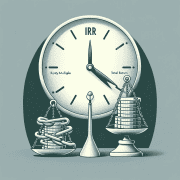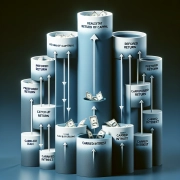IRR vs Discount Rate: Two Sides of the Same Coin (Case Study + Model)
In the discipline of commercial real estate financial modeling, certain principles serve as foundational pillars, essential across all valuation, acquisition, and investment analyses. Few concepts are as omnipresent, yet as frequently misunderstood, as the Internal Rate of Return (IRR) and the Discount Rate. So let’s discuss the IRR vs Discount Rate in commercial real estate analysis.
These two metrics are cornerstones of our field. They’re introduced in finance classrooms, implemented daily in institutional underwriting, and embedded within virtually every Excel model we build. Yet, despite their prevalence, their distinctions are often blurred. Are they interchangeable? Contradictory? Or perhaps complementary?

A realistic cinematic golden coin standing upright on a rooftop at sunset, symbolizing two sides of the same concept, natural lighting with warm sunlight reflecting on the coin and glass city buildings.
The answer lies in nuance. While IRR and the Discount Rate are conceptually distinct, they function in close concert. In fact, the most robust understanding emerges when we view them as dual perspectives on investment value. To unpack this relationship, we must first define each term with clarity, then examine how they intersect in the architecture of real estate cash flow modeling.
The Internal Rate Of Return (IRR): A Product Of Investment Performance
At its core, the IRR is a rate of return metric derived entirely from the internal cash flows of an investment. It represents the compounded annual growth rate that equates the net present value (NPV) of an investment’s cash inflows and outflows to zero.
Put more simply, the IRR tells us the rate of return the project generates on its own merits. It requires no external benchmark to calculate. If you know the timing and magnitude of the investment’s cash flows, from initial outlay to operations, to final sale, you can calculate its IRR.
For this reason, IRR is properly viewed as an output. It is the result of the investment’s actual economics, not the investor’s required hurdle.
The Discount Rate: An Input For Decision-Making
The Discount Rate, by contrast, is not a product of the investment’s cash flows but of the investor’s expectations. Often referred to as the required rate of return, hurdle rate, or opportunity cost of capital, the Discount Rate reflects what investors demand in exchange for committing capital to a project.
In institutional real estate, the Discount Rate usually starts with the average cost of the investor’s capital, then is adjusted to account for the specific risks of the property, the type of investment strategy, such as core, value-add, or opportunistic, and current market conditions.
When we apply a Discount Rate in a discounted cash flow (DCF) analysis, we are using it to convert future cash flows into present value terms. In doing so, we answer the question: Given our required return, how much should we be willing to pay for this stream of future cash flows today?
Thus, the Discount Rate is best understood as an input. It is an assumption the investor brings to the table, rather than something the project itself produces.
IRR vs. Discount Rate: Where They Align
With these distinctions in mind, why are IRR and Discount Rate so often confused? The answer lies in how the two interact in practice.
Consider the process of sizing the purchase price for an acquisition. An investor sets a target return, say, an 8% gross unlevered IRR. They forecast the unlevered cash flows of the property, then discount those cash flows back at 8% to determine the maximum price they are willing to pay today.
That present value becomes the purchase price. And because the cash flows were discounted at the required return, the IRR of those cash flows, when using that purchase price as the initial outlay, will equal exactly 8%.
This is where the “two sides of the same coin” analogy comes into play. The Discount Rate is the investor’s requirement; the IRR is the project’s performance. When the price is set to align the two, the IRR equals the Discount Rate.
Divergence: When IRR And Discount Rate Part Ways
Of course, in real-world deals, IRR and Discount Rate do not always match. If the investor pays less than the maximum price calculated at the required return, the IRR will exceed the Discount Rate, and the NPV will be positive. If they pay more, the IRR will fall short of the Discount Rate, and the NPV will be negative.
This divergence highlights the decision-making power of the DCF framework. The Discount Rate serves as the benchmark; the IRR serves as the scorecard. Together, they inform whether the investment creates or destroys value relative to the investor’s opportunity cost of capital.
The Practical Takeaway For Real Estate Professionals Comparing IRR vs Discount Rate
For those of us building and interpreting real estate financial models, it is critical to maintain clarity on the distinction between these two concepts:
Discount Rate = Input (investor’s required return)
IRR = Output (project’s actual return)
Yet it is equally important to recognize how tightly they are linked in practice. When used together, they form the framework for nearly every valuation exercise we perform.
So, the next time you size a purchase price, run a DCF, or debate whether a deal “pencils,” remember: IRR and Discount Rate are not the same, but they work together as the mirror image of one another, two sides of the same coin that, when understood in tandem, provide clarity to the investment decision-making process.
Case Study – Keystone Ridge Office Park
Granite Hill Partners, a value-add real estate private equity firm based in Atlanta, is underwriting the acquisition of Keystone Ridge Office Park, a 96,000 square foot suburban office park located in the Raleigh-Durham metro. The property, built in 2003, consists of three two-story buildings situated on 7.5 acres. It is currently 80% occupied, with a mix of professional service tenants and a few regional headquarters. The property presents a classic value-add opportunity through leasing, cosmetic renovations, and improved management.
Granite Hill’s investment committee requires a 10% unlevered return for suburban office investments with moderate leasing and execution risk. This return hurdle, based on market risk premiums, cost of capital, and asset strategy, represents the firm’s Discount Rate.
Granite Hill’s associate, Rachel, prepares a 10-year DCF model. Her pro forma includes:
- Starting NOI of $1,250,000 in Year 1
- NOI growth of 2.5% annually
- Exit at the end of Year 10, with terminal value based on Year 11 NOI and a 7.00% exit cap rate
Step 1: Calculate the Purchase Price Using the Discount Rate
To determine the maximum price Granite Hill should pay to meet its return requirement, Rachel discounts the projected cash flows at the 10% Discount Rate.
Using the DCF method:
Present Value (i.e., Purchase Price) = $17,254,200
At this price:
NPV = $0
Discount Rate = 10%
IRR = 10%
When the investor pays exactly what the discounted cash flows are worth at the required return, IRR equals the Discount Rate, and NPV is zero. Because she used the required return (10%) to discount the projected cash flows and solve for the present value, the investment’s Internal Rate of Return (IRR) is also 10%, a perfect match.
Step 2: Test IRR at Higher and Lower Purchase Prices
Rachel explores how the IRR changes when the acquisition price deviates from the DCF-implied value.
Scenario 2: Value Creation
Purchase Price = $16,000,000
Discount Rate = 10.0%
IRR = 11.12%
NPV > $0
Buying below the present value of cash flows increases return above the hurdle rate and creates value. In other words, the asset is being acquired at a discount to its intrinsic value, and the investor is earning more than their required return.
This is a “good deal” in purely financial terms. Because the investor is paying less than what the future cash flows are worth at a 10% discount rate, the deal offers a return surplus over the required hurdle.
Scenario 3: Value Destruction
Purchase Price: $18,000,000
IRR = 9.38%
Discount Rate = 10.0%
NPV < $0
Here, the asset is being acquired at a premium to its intrinsic value, so the investor is earning less than their required return. The negative NPV indicates that capital is being deployed inefficiently.
This deal destroys value from a return-on-capital perspective, because the investor is paying more than the present value of the future cash flows, given the required return. The project underperforms the benchmark.
Key Takeaways
This case illustrates how IRR and the Discount Rate, while distinct in concept, are closely intertwined in application. The Discount Rate serves as Granite Hill’s internal benchmark, a reflection of the return they require in exchange for taking on investment risk. The IRR, by contrast, reflects what the deal is actually projected to deliver based on its specific cash flows and purchase price.
In other words, the Discount Rate, set at 10%, is an input, shaped by risk expectations and investment strategy. The IRR is the output, revealing what the modeled cash flows yield given that pricing.
Now, when the IRR exceeds the Discount Rate, the investment creates value. When it falls short, it destroys value.
By viewing these two metrics together, Rachel is equipped to rigorously evaluate the deal, guide pricing discussions, and present a well-supported recommendation to the investment committee. This framework helps the entire team answer critical questions: What is the asset worth to us? At what price should we acquire it? And does it meet our return threshold?
Overview: IRR Vs Discount Rate Analyzer Model
The IRR vs. Discount Rate Analyzer Model is a simple yet powerful educational tool designed to help real estate professionals understand the dynamic relationship between an investment’s internal return (IRR) and the investor’s required return (Discount Rate). Built in Excel, this model illustrates how changes in purchase price impact both IRR and Net Present Value (NPV), thereby providing a clear, intuitive framework for pricing real estate deals.
At its core, the model takes projected unlevered cash flows from a stabilized property, e.g., Keystone Ridge Office Park, and compares three investment scenarios, each with a different acquisition price. The model applies a fixed Discount Rate (e.g., 10%) to estimate the maximum price the investor should pay to achieve their required return. It then calculates the IRR and NPV for different scenarios, highlighting whether value is created, maintained, or destroyed.
This tool is ideal for both learning and decision support. Whether you’re a student grasping the fundamentals of DCF modeling or a practitioner validating your pricing assumptions, the IRR vs. Discount Rate Analyzer offers a practical demonstration of how investor inputs and project-level outputs interact in professional underwriting.
Version Tab
The Version tab functions as the model’s homepage, providing users with a clear record of all updates through a detailed change log, while also offering direct access to helpful resources (including tutorials, user guides, and additional support materials) to ensure a smooth and informed modeling experience.
DCF Tab (Primary Calculation View)
The DCF tab serves as the central engine of the IRR vs. Discount Rate Analyzer Model. This is where the core underwriting occurs, calculating cash flows, IRR, NPV, and ultimately demonstrating how different purchase prices impact investor outcomes. The tab is divided into intuitive sections that guide the user through a step-by-step breakdown of potential investment performance.
Inputs are clearly distinguished in blue font, allowing users to easily manipulate key variables such as Net Operating Income, Exit Cap Rate, and the Discount Rate. These inputs drive the valuation logic and enable quick testing of assumptions across different deal strategies.
Black font cells represent outputs and calculations that flow directly from the inputs. The first calculation block outlines the potential investment cash flows, beginning with Net Operating Income, then subtracting capital expenditures (if any), and finally deriving the Cash Flow from Operations and Total Cash Flow, including the terminal reversion value. These cash flows are used to calculate a maximum purchase price based on the investor’s Discount Rate, providing a “breakeven” price where IRR equals the required return.
The second block includes the Discounted Cash Flow schedule, where unlevered investment, operating, and reversion cash flows are laid out across the 10-year hold. Using the Present Value at Discount Rate, the model derives the IRR and NPV, reinforcing the conceptual distinction between the investor’s input (Discount Rate) and the project’s output (IRR).
Finally, the Purchase Price Sensitivity table at the bottom compares three pricing scenarios side-by-side. For each, the model calculates IRR and NPV, clearly indicating whether value is created (IRR > Discount Rate), preserved (IRR = Discount Rate), or destroyed (IRR < Discount Rate).
Download the IRR Vs Discount Rate Analyzer Model
To make this model accessible to everyone, it is offered on a “Pay What You’re Able” basis with no minimum (enter $0 if you’d like) or maximum (your support helps keep the content coming – typical real estate Excel models sell for $100 – $300+ per license). Just enter a price together with an email address to send the download link to, and then click ‘Continue’. If you have any questions about our “Pay What You’re Able” program or why we offer our models on this basis, please reach out to either Mike or Spencer.
We regularly update the model (see version notes). Paid contributors to the model receive a new download link via email each time the model is updated.
Frequently Asked Questions about IRR vs Discount Rate (Case Study + Model)
Version Notes
v1.0








